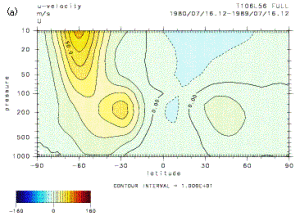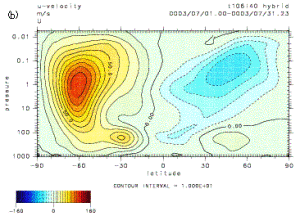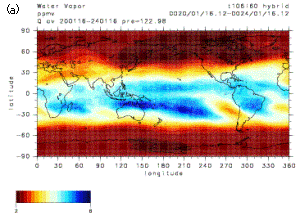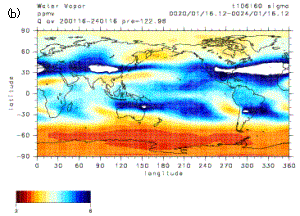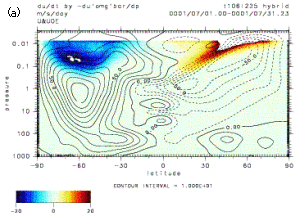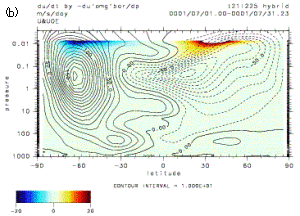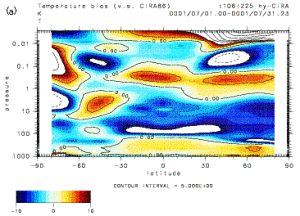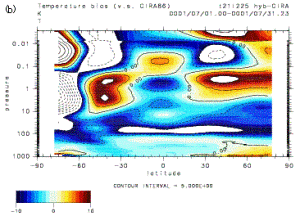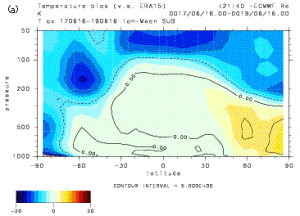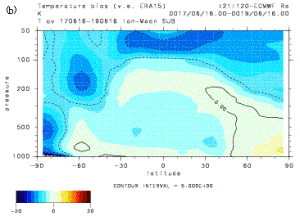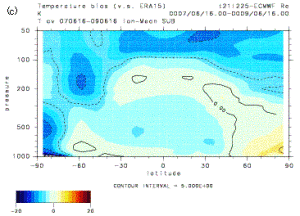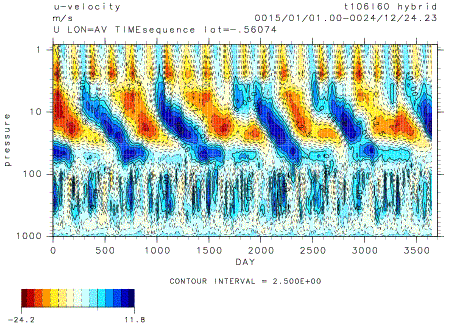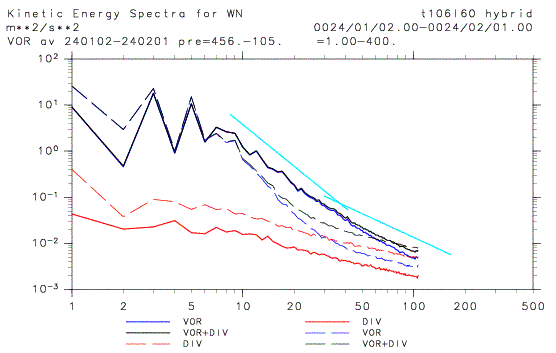4. Climate physics core model improvementResults Page | Top Page |
|||||||||||||||
|
The organization in charge: Earth frontier research system
a. SummaryImprovement or the model taken in newly is developed for many processes of the stratosphere by the climate model (a CCSR/NIES model, existing) of the atmosphere, the ocean, and a land side which consists mainly of a physical process. About improvement of an air model, improvement of many processes of an inadequate middle atmosphere (the stratosphere and mesosphere) is aimed at by the present model. That is, while change of the radiation from the physical chemistry process and the sun of an ozone layer peculiar to a middle atmosphere influences each other mutually and causes change of a middle atmosphere by invasion of the artificial origin substance to the inside of a middle atmosphere, it clarifies the mechanism which combines with change of the lower layer troposhere and produces a climate change by model experiment. Moreover, the action of internal gravity wave and it clarify influence affect atmospheric circulation by a super-high resolution air model.the experiment to which this fiscal year extended the upper bed of a climate model to the up mesosphere (80km), and the tuning parameter of horizontal / vertical resolution of a model and a physical process was changed -- tens case 行う -- the importance of the role of the airwave which governs various process of a middle atmosphere has been recognized by things. The resolution attained in the simulation of this fiscal year is a level T106 (1.1-degree lattice) and 200m of perpendicular thickness. Moreover, when it changed and experimented in resolution, it investigated [ the computer resource of an Earth Simulator, and ] how much actual computation time are needed. Moreover, although a possibility which is more than near the tropopause which the perpendicular coordinate system used by the conventional model is a sigma coordinate system, and is distant from surface of the earth that a problem would arise in expression of dynamics process if advanced was pointed out, the calculation accuracy more than the stratosphere improved by changing this into a sigma-p hybrid coordinate system. On the other hand, although investigation about the details of that actual condition and the process used as a cause was advanced about the low temperature and the humectant bias near [ which is a problem peculiar to this model ] the tropopause, that solution was left behind as a subject of the following fiscal year. b. Research purposeThere is the purpose of this research in understanding better various process in the atmosphere connected with it to be development and improvement of a climate physics model. In order to simulate correctly the interaction process of the change and climate of atmospheric composition in a middle atmosphere, the temperature place of the air motion which governs transportation of an air minor constituent or aerosol, and the atmosphere important for photochemical-reaction process especially needs to be appropriately reproducible.Cooling by heating which the large-scale circulation in a middle atmosphere, the seasonal variation of a temperature place, and solar-ultraviolet-radiation absorption according to ozone in order to more often reproduce change every year bring about, and the infrared radiation to which the greenhouse-effect gas made into representation releases carbon dioxide, methane ozone, and steam, i.e., radiation process, and various airwaves ranging from hundreds of m to a planet scale are considered need to be appropriately expressed in a model, respectively. In order to express radiation process and a small-scale airwave correctly, it is thought that horizontal / vertical resolution of a model must be to some extent high. However, resolution sufficient required when conducting the warming prediction experiment included to the interaction with atmospheric composition change over a long period of time is not clear enough even now. It is scientifically meaningful to carry out clear [ of the dependability over the model resolution of each process ] by large-scale calculation using an Earth Simulator, and it is the main subject of this sub thema while it is indispensable for the design of an integrated model. In the overall plan, while setting development of all the high resolution ball air models used as the foundation of a final integrated model as a long-term target, development is performed and offer of the air model united with the needs of each subgroup (partial integrated model) is due to be performed. c. A research program, a method, a scheduleImprovement or the model taken in newly is developed for many processes of the stratosphere by the climate model (a CCSR/NIES model, existing) of the atmosphere, the ocean, and a land side which consists mainly of a physical process. In order to adopt correctly the temperature of the stratosphere and the mesosphere atmosphere, and the effect of the internal gravity wave which plays a big role in circulation and substance transportation, it is necessary to do a numerical simulation by the horizontal resolution of 20km and the about [ vertical thickness 100m ] model which do not carry out the parameter rise of the internal gravity wave but as for which direct picking treats it. This experiment will be conducted by 2nd, and while even a middle atmosphere is included, it enables it to include new parameterization in resolution atmospheric chemistry and a climate joint model in 3rd. The chemistry and the climate joint model containing a middle atmosphere are sub thema (2). - Development - of "warming and an atmospheric composition interaction model" cooperates and balances, development is furthered, and it experiments by inside resolution models, such as a synergistic effect of ozone layer depletion and warming.d. The research program in FY 2002About a physical climate core model, even the stratosphere and the mesosphere to the altitude of about 80km are included, and the work which makes perpendicular resolution high simultaneously is started. Consideration of the suitable process model for an integrated model is also performed in middle atmosphere chemistry (ozone stratification study) process. In parallel, improvement of the problem of the present climate model is also performed.e. Reports in FY 2002e-1) Extension of a model upper bedFirst, the perpendicular calculation range of a model was extended. Specifically, the upper bed of a CCSR/NIES model was raised to 80km from less than 50 conventionalkm. By this, all the stratosphere and mesospheres can be expressed now, and a possibility that the change of atmospheric composition and the change of climate over a long period of time could be predicted appropriately increased. As an example, the beltlike average zonal wind in July is shown in Fig. 1. figure 1a -- the result of the conventional model -- it is -- the winter of the Southern Hemisphere -- a west wind -- neither the upper part of a jet nor summer Kochi of the Northern Hemisphere is expressed. On the other hand, figure 1b is as a result of the model which set the upper bed to 80km. moreover, seasonal advance of the lower stratosphere which is related to development of an ozone hole -- also being related -- the west wind of winter hemisphere -- the more exact simulation became possible from the ability of all of a jet or Jet Kochi of summer hemisphere to be expressed now.
e-2) Change of a perpendicular coordinate system Generally it is used by the middle atmosphere model from the conventional sigma coordinate system, and the perpendicular coordinate system of a model was changed into the sigma-p hybrid coordinate system it is expected from the up troposhere that an improvement of the circulating space in a middle atmosphere and substance transportation is. Distribution of minor constituent gas (steam) changed in connection with this. the steam of a 120hPa side when a sigma-p hybrid coordinate system is used for figure 2a -- mixing ratio and figure 2b -- the conventional &sigm a; it is as a result of a coordinate system. When sigma coordinate system is used, in order that the coordinate plane of a model may rise around mountains geographical feature, When a sigma-p hybrid coordinates system is to the tendency for the lower stratosphere to become humectant having been seen according to the effect that the air containing many lower layer steam flows out toward mountains' lees (the direction of a right hand), such as Himalaya, the Rockies, and the Andes, (figure 2b), it turns out that such a bad influence is removed (figure 2a).
e-3) The response of the model atmosphere to the difference in the parameter of horizontal / vertical resolution - and a physical process The parameter of horizontal / vertical resolution of a model and various physical process was changed, and the difference in the response of a model atmosphere to it was investigated. in the experiment which amounts to tens of examples, although [ every / during several years ] repeated, actual work arranges only the result with the main experiment setup, and lists it to below. e-3-1) Horizontal resolutionIt is important to raise the horizontal resolution of a model in the point that expression of the small-scale internal gravity wave which plays a role important for formation of general circulation is attained, also not only in the meaning which raises the reproducibility of the climate of the troposhere but the middle atmosphere that distribution of more detailed temperature or precipitation can be reproduced now. For example, the "high latitude low-temperature bias" that apply to winter-spring and the temperature of the polar lower stratosphere tends to turn into low temperature as a big problem common to a general circulation model as compared with observation exists. It considers that expression of a small-scale internal gravity wave is inadequate as the main cause (for example, Hamilton et al., 1999). The color scale of Fig. 3 shows the distribution of speedup and a slowdown of the zonal wind accompanying the momentum transfer of a gravity wave in the experiment which performed horizontal resolution by T106 (1.1-degree lattice) and T21 (5.6-degree lattice). By the result of July, all have taken perpendicular resolution so that it may become 500m 200m and near a model upper bed in the stratosphere. It turns out that the one where horizontal resolution is higher expresses more gravity waves, it is more strong and the beltlike average zonal wind is decelerated from the lower altitude as a result. If the distribution of a zonal wind expressed with the isoline is seen, the thing of low resolution is about 170 m/s to the thing of high resolution of the peak of the polar night jet of Southern Hemisphere winter being about 110 m/s.
Fig. 4 expresses what expressed the same temperature place of an experiment by the gap from observation (CIRA86), i.e., bias. Signs that the low-temperature bias of the high latitude stratosphere of Southern Hemisphere winter is improved are known, so that horizontal resolution becomes high. With low resolution, 50 degrees C or more of a certain low-temperature bias are small to about 15 degrees C with high resolution.
e-3-2) Perpendicular resolution It is pointed out to the place and air wave motion of the large-scale flow which raises only the horizontal resolution of GCM and is reproduced [ that perpendicular resolution is still relatively low and ] that a problem arises (Lindzen and Fox-Rabinovitz 1989). Moreover, in order to simulate correctly transportation of radiation process or a minor constituent, and the loss process of a gravity wave, sufficient perpendicular resolution is needed. For this reason, it experimented by changing perpendicular resolution. Although detailed analysis about a wave motion was yet omitted, by making perpendicular resolution high showed that the low temperature and humectant bias of the lower stratosphere which is a problem peculiar to this model (CCSR/NIES AGCM) were improved to some extent. Fig. 5 shows change (beltlike mean temperature bias in June) of the reproducibility of a temperature place when making perpendicular resolution fine from about [ of having been conventionally used by the medium-rise general circulation model ] 1500m to 200m. the numerical value of these figures -- the result of a simulation to ECMWF -- re--- it expresses that the result of a simulation is so good that the value of analysis data:ERA15 is pulled and an absolute value becomes small. In addition, the result has shown the last average for three years with which it integrated for several years. From this result, by making perpendicular resolution high shows that the low-temperature bias near a troposhere interface (50-300hPa) is improved from the lower stratosphere. Moreover, although the figure was not shown, by raising perpendicular resolution showed that transportation in the superfluous stratosphere of steam was controlled in near a troposhere interface also about humectant bias. Since humectant bias can cause low-temperature bias through the radiative cooling of steam, more detailed analysis is required for it.
e-3-3) Reappearance of a gravity wave energy spectrum and the stratosphere equator QBO Even if it makes only horizontal / vertical resolution high, it does not reappear appropriately, therefore the reproducibility of the gravity wave in a model of the climate place of air general circulation does not improve, either. In order to more often reproduce a gravity wave, it is necessary to tune up the parameter of two or more physical process appropriately. In these parameters, it was confirmed being horizontal proliferation about loss of a gravity wave and that the threshold value (RHc) of the relative humidity in cumulus convection parameterization about excitation is especially important. (It referred to 2002 besides a crossing about RHc.) ) Six shows semi- two-year vibration (QBO) of the stratosphere equatorial zonal wind reproduced in the resolution of Fig.T106L60 (the perpendicular resolution ofkm [ about 50 ] and the lower stratosphere of an upper end is about 500m). Signs that a zonal wind takes the place in a cycle of about 25~27 months centering on near about 20hPa are seen. Although amplitude is a little small compared with what is observed, it is surmised that the lowness of the upper end of a model, shortage of perpendicular resolution, etc. are the causes. In addition, as a review of QBO, Takahashi (1996, 1999), Horinouchi and Yoden (1998), Hamilton et al. (2002), etc. are mentioned about the reappearance of QBO by GCM which does not use Baldwin et al. (2001) and gravity wave parameterization.
Fig. 7 shows all the cycle spectra of the class leveling movement energy at this time. The black solid line of a figure is a cycle about at the about bigger cycle to the 3rd [ -] power of a cycle in the range of all the cycles 10-40 than it, if the inclination is observed, although the energy spectrum of the net in the up troposhere is expressed. - The number of high waves is known by that energy is weak according to the 5/3rd power. These show the actual spectrum distribution obtained from airplane observation, and good coincidence (Nastorm et al., 1984). Although the red line of a figure expresses an emission ingredient among class leveling movement energies, the most is related with an internal gravity wave. Especially in the stratosphere, it turns out that the energy which a gravity wave has with reduction of air density increases, and it especially comes to occupy the great portion of net energy with the number of high waves. The quantity-of-motion transportation by this gravity wave ingredient is considered to be especially important for reappearance of QBO (for example, Dunkerton, 1997, Horinouchi and Yoden, 1998). In order to reproduce simultaneously inclination of the energy spectrum near such an observation fact, and QBO from the result of the sensitivity experiment conducted by changing many parameters, it turned out that it is necessary to tune up somewhat briskly the parameter about horizontal proliferation and a cumulus convection. In the case of T106, about horizontal proliferation, it needed to change into diffusion of ∇8 and the dumping time to the maximum cycle needed to be made into about one day from standard diffusion of ∇4. Moreover, in order to excite the gravity wave which had a suitable spectrum between space-time from the cumulus convection, the parameter RHc about the judgment of convection generating was suitably adjusted according to perpendicular resolution. e-4 The supplement about extension of the perpendicular range of a model, and the determination of perpendicular resolutionIn this research, it referred to existing Kyushu University GCM (Miyahara et al., 1995) and SKYHI GCM (Fels et al., 1980) of GFDL, and developed bearing in mind raising perpendicular resolution farther than them. The knowledge experientially acquired through model development below is described.
When taking perpendicular layer thickness uniformly expressed propagation and loss process of an internal gravity wave correctly, it was important, but when saying from the field of calculation stability and perpendicular layer thickness was made to increase to alignment with an altitude, it was checked that integration becomes possible at high speed at a more stable more long time step. (In the case of the same number of perpendicular layers, actual calculation cost became about 60 percent.) SKYHI GCM is begun, and other GCM(s) make perpendicular resolution coarse with the altitude similarly, and perpendicular -- high -- although it is resolution, it is thought that it is effective not to observe the gravity wave itself but perform the spin rise of a model stably for a short time. When layer thickness was made to increase at a rate other than alignment, it also checked that the discontinuity which was conspicuous in the zonal wind of the model atmosphere or perpendicular propagation of an air wave motion arose.
Moreover, since it was generated also when perpendicular distribution of the ozone data used for calculation of radiation was discontinuous, the same discontinuity performed necessary minimum smoothing to the ozone data to be used.
Since it turned out in the application altitude that remarkable discontinuity appears in the model atmosphere when it applied to a perpendicular high resolution model, Rayleigh friction generally used by GCM on the other hand since the slowdown of the zonal wind by a gravity wave is approximated stopped use except the sponge layer near a model top end. As a result, for example, the resolution of T106L250 (a 1.1-degree lattice, 300m of perpendicular layer thickness), about 20 to 30 m/s of polar night jets of inside and high latitude is [ hemispheres / both / observation ] strong, and the reproducibility of the half a year periodic vibration of a stratosphere interface or the half a year periodic vibration of mesosphere is getting worse in low latitude. While conducting the experiment which raised horizontal / vertical resolution more, it is necessary to raise the upper end of a model to a slight degree, and to tackle improvement from now on.
f. ConsiderationIt can be said that the result beyond it as the overall almost original research program was attained. Although the big improvement was found by steam transportation with renewal of a perpendicular coordinate system, change of the circulating space of the mountains geographical feature circumference itself is various in a place or a season, and was not able to judge from easy analysis whether it was what is depended on change of a coordinate system. I want to consider it as future subjects.
About the response of the model medium-rise atmosphere to improvement in horizontal resolution, the result of SKYHI GCM using the 0.3x0.33-degree lattice exceeding the 1.1-degree lattice of T106 already investigated this time is published (Hamilton et al., 1999). However, their model is based on the lattice approach and a result may differ from our model using a spectral method. It is necessary to conduct the experiment which raised horizontal resolution more from now on, and to verify in detail.
perpendicular as the medium-rise atmosphere GCM, when the world is overlooked about the response of the model atmosphere to improvement in perpendicular resolution in the lower stratosphere -- it is the highest which considers it as about layer thickness 500-700m, and makes perpendicular resolution coarse with the altitude, and the number of perpendicular layers is 80 to 90 layers (Hamilton et al., 1999, Giorgetta et al., 2002). That calculation is possible over sufficient period at present with the preceding clause in resolution called 200 to 300 m shown in the example is only our model which used the Earth Simulator. Since it is called for that perpendicular layer thickness becomes the order which is 100m in order to express propagation and wave breaking of an internal gravity wave correctly, it is necessary to continue development further from now on. Moreover, a more detailed examination is required even if it turns to the improvement of the low temperature and humectant bias of the lower stratosphere.
About all the cycle spectra of the kinetic energy containing an internal gravity wave, there is a paper which compared the result of the medium-rise atmosphere GCM of various horizontal resolution (Koshyk et al., 1999). Horizontal resolution is T42 (2.8-degree lattice) grade, and the gravity wave near the minimum scale which can express a model was numerically removed as a noise which brings about computational instability in the model for the conventional climate model which can express only a comparatively large-scale thing among internal gravity waves, or numerical weather prediction. Also in today's GCM to which horizontal resolution was raised, there were many examples which are smaller than the spectral intensity which stronger horizontal proliferation is made to act to the wave of the number of high waves, and is observed because of such a circumstances.
In the model under development, the reproducibility of a gravity wave was thought as important, and it adjusted so that inclination of a spectrum might approach the observation fact as one index. However, since it is in a little small tendency as compared with other models using a different cumulus convection scheme about the intensity of a spectrum itself, I want to also perform consideration of the hit from now on. Moreover, I want to investigate in detail wave breaking of not only the lower stratosphere altitude that QBO produces but an internal gravity wave also about behavior of the gravity wave in the up mesosphere produced frequently using the model of high resolution from future.
Finally, although this report is not describing, into the following fiscal year, parameterization (Hines 1997 a, b) of a gravity wave is due to be introduced in the inside resolution version GCM. It is due to take the initiative in it, to perform direct comparison with the parameter of the gravity wave in the medium-rise atmosphere GCM of the super-high resolution version, and to grope for the mounting method of more suitable parameterization. Acknowledgement : Calculation of this research was performed using the Earth Simulator. GFD-DENNOU Library and GTOOL were used for drawing. About change of a perpendicular coordinate system, derivation of an equation system and the great portion of actual work were done by the hand of Mr. Miura who is the graduate student of the Center for Climate System Research, University of Tokyo graduate school (Miura, private letter). g. Quotation referenceBaldwin, M. L. J. Gray, T. J. Dunkerton, K. Hamilton, P. H. Haynes, W. J. Randel, J. R. Holton, M. J. Alexander, I. Hirota, T. Horinouchi, D. B. A. Jones, J. S. Kinnersley, C. Marquardt, K. Sato and M. Takahashi, The Quasi-Biennial Oscillation, Rev. Geophys., 39, 179-229, 2001.Dunkerton, T. J., The role of gravity waves in the quasi-biennial oscillation, J. Geophys. Res., 102, 26,053-26,076, 1997. Fels, S. B., J. D. Mahlman, M. D. Schwarzkopf and R. W. Sinclair, Stratospheric sensitivety to perturbations in ozone and carbon dioxide: radiative and dynamical response, J. Atmos. Sci., 37, 2265-2297, 1980. Giorgetta, M. A., E. Manzini and E. Roeckner, Forcing of the quasi-biennial oscillation from a broad spectrum of atmospheric waves, Geophys. Res. Lett., 29, 8-86., 2002. Hamilton, K ., R. J. Wilson and R. S. Hemler, Spontaneous stratospheric QBO-like oscillations simulated by the GFDL SKYHI general circulation model, J. Atmos. Sci., 58, 3271-3292, 2002. Hamilton. K, R. J. Wilson and R. S. Hemler, Middle atmosphere simulated with high vertical and horizontal resolution versions of a GCM: Improvements if the cold pole bias and generation of a QBO-like oscillation in the tropics, J. Atmos Sci., 56, 2829-3846, 1999. Hines, C. O., Doppler-spread parameterization of gravity-wave momentum deposition in the middle atmosphere. Part 1: Basic formulation, J. Atmos. Solar Terr. Phys., 59, 371-386, 1997a. Hines, C. O., Doppler-spread parameterization of gravity-wave momentum deposition in the middle atmosphere. Part 2: Broad and quasi monochromatic spectra, and implementation, J. Atmos. Solar Terr. Phys., 59, 387-400, 1997b. Horinouchi, T and S. Yoden, Wave-mean flow interaction with a QBO-like oscillation simulated in a simplified GCM, J. Atmos. Sci., 55, 502-526, 1998. Koshyk, J. N., B. A. Boville, K. Hamilton, E. Manzini and K. Shibata., Kinetic energy spectrum of horizontal motions in middle-atomosphere models, J. Geophys. Res., 104, 27,177-27,190, 1999. Lindzen, R and Fox-Rabinovitz, Consistent vertical and horizontal resolution, Mon. Weather Rev., 117, 2575-2583, 1989. Miura, H., Vertical differencing of the primitive equations in a Sigma-p hybrid coordinate (For Spectral AGCM), CCSR Internal Report, University of Tokyo, in press. Miyahara, S ., Y. Miyoshi, T. Kayahara, Y. Yoshida, M. Ooishi and T. Hirooka, Development of a middle atmosphere general circulation model at Kyushu University, Climate System Dynamics and Modeling, Center for Climate System Research, University of Tokyo, pp. 75-103, 1995. Nastorm, G. D., K. S. Gate and W. H. Jasperson, Kinetic energy spectrum of large-and mesoscale atmospheric processes, Nature, 310, 36-38. 1984. Takahasi, M., Simulation of the stratospheric quasi-biennial oscillation using a general circulation model, Gephys. Res. Lett., 23, 661-664, 1996. Takahashi, M, Simulation of the quasi-biennial oscillation in a general circulation model, Geophys. Res. Lett., 26, 1307-1310, 1999. The influence and the collection of the Meteorological Society of Japan spring convention lecture drafts in FY 2002 which are exerted on the QBO cycle of a troposhere cumulus convective activity besides a crossing, pp.58, 2002. h. The announcement of a result< oral Announcement & gt;S. Watanabe, Development of a middle atmosphere GCM at the Frontier, GRIPS annual workshop, Mar 6 2003, Washington D.C., USA. |
